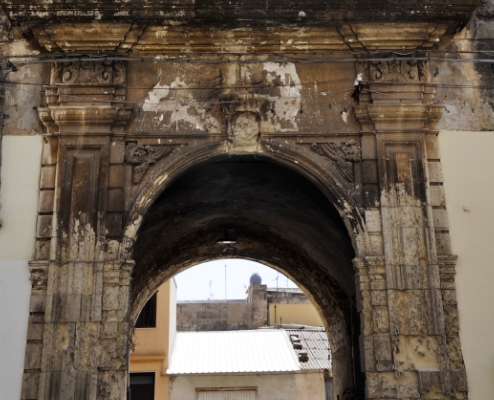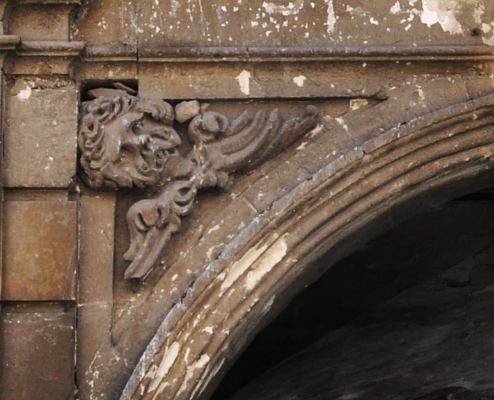GUTTADAURO PALACE
1716-1752
Private property, not open to visits.
Guttadauro Palace, located in the S. Giovanni Battista district and overlooking the former Strada S. Pietro (Via Linneo), was built by Stefano Sirugo, Baron of Vignazze and son of Giuseppe (†1690), who was ennobled in 1682 for his prowess on the battlefield.

The contract to build the Casa Palazzata (Palazzo-style house) was drawn up by the baron in 1716 with the magister Michelangelo Alessi of Syracuse, already in Avola to work on the Mother Church. On one side the Palazzo adjoined the Church of St. Peter that was built between 1705 and 1706 by Baroness Anna Sirugo Lorefice (†1720), mother of Stefano.
The Domus Magna, built on the exterior of the hexagonal perimeter of the city design by the Jesuit architect Angelo Italia after the earthquake in 1693, was in the Pantanello district, which bordered on the new city plan and had been acquired from the University of Avola in perpetual emphytesis by Stefano Sirugo.
The palazzo facade is Renaissance in style with baroque decorations. Between the corbels of the crowning cornice there are shell motifs alternating with grotesques supposed to ward off evil spirits, such as the bust on the keystone of the elegant portal. On the front wall there is a beautifully executed votive aedicule with a split triangular pediment and two lateral pine-cones over it.

In 1743 the Baron was a widower with no heirs. He took vows in the Order of the Carmelite Monks under the Strict Syracuse Rules of Observance, took the name of Brother Stefano of the Heart of Jesus and gave his assets and title to his nephew Saverio Guttadauro, already the Marquis of Ficarra, who was born in Vizzini in 1710 to his sister Anna Guttadauro Sirugo. Saverio became the third Baron of Vignazze, and in 1752 extended the house, which already comprised «22 parts», portico, balconies, storehouses, workshops, wells and cisterns, with a new Great Hall where he had mirrors and damask chairs installed.
The “Marquis Guttadauro”, as he normally referred to himself, married Lucia Salonia in 1746 in Syracuse and had twelve children, including Giuseppe, a Knight of Justice in the Order of Malta. His father included his name in the scroll on the Plan of Avola, drawn in 1693 by Angelo Italia and re-engraved in 1756 in order to be included under the listing Abola in the Lexicon Topographicum Siculum published in 1757 by the abbot and historian from Catania Vito Maria Amico.

Saverio Guttadauro was a poet and a man of letters. He died in Avola in 1780 and was buried in the church of the former Dominican monastery, which was demolished and became the site of the Palazzo di Città. Saverio was succeeded by his son Raffaele and subsequently the property was passed on from father to son to Concetto, Raffaele II and Concetto II. In the second half of the nineteenth century the male line of the Guttadauro di Avola became extinct and the eighteenth-century building became the property of the Bonincontro family before being subsequently split into smaller apartments.
Explore the historic center of Avola!
Welcome to Avola, the hexagonal city! Explore the historic center.
Explore the historic center of Avola!
Welcome to Avola, the hexagonal city! Explore the historic center.
